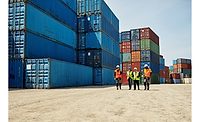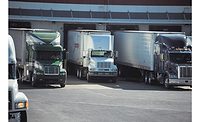Supply Chain
Unlocking Supply Chain Resiliency and Sustainability for Food and Beverage Manufacturing

Photo by Masaaki Komori on Unsplash
Post-pandemic, food and beverage supply chains face various challenges, ranging from rising costs and complexity to shortages of raw materials and labor constraints. These pressing issues require food industry stakeholders to reimagine and restructure their supply chain planning and processes.
Internal teams must gain enhanced visibility into volatile supply, demand and pricing fluctuations to thrive in this rapidly evolving landscape. There is also pressure to integrate social responsibility into supply chain plans. Increased collaboration can help with these issues and increased transparency and traceability are required for efficient operations.
Contemporary Supply Chain Management (SCM) technology can be key in achieving supply chain resiliency and sustainability for the food and beverage manufacturing sector.
The Role of Optimization in Mitigating Challenges
Production, manufacturing, and logistics are the three pillars of SCM. Each is facing the same challenging opportunity to improve both internal processes and external coordination with the other two.
Food producers generally turn to recipe formulation and ingredient optimization as a first step in countering volatile commodity prices. Packaging manufacturers must engineer and execute more efficiently to reduce the landed cost of commodity items and meet consumer demands for sustainability. In parallel, logistics organizations must optimize their routes for inbound/outbound transportation and last-mile retail operations to ensure on-time delivery with reduced costs, fuel consumption and emissions. Intelligently scheduling production, packing, and delivery staff is also essential to optimize operations and the workforce within the limitations.
Unlocking Opportunities through Connected Supply Chains
Effective planning optimizes supply chain flows and reduces environmental impacts by enhancing resource, material and energy efficiency. Connecting the supply chain to product and production operations opens new doors for driving sustainability initiatives.
Some notable opportunities include:
- Virtual twin technology that enables product design and formulation integration with supply chain planning, leading to an efficient production system built for scalability with minimal waste.
- Efficient product design, formulation, and logistics that help limit the presence of perishable or short-lifecycle goods in the supply chain, reducing waste and spoilage.
- Connecting supply chain planning to downstream operations and consumer feedback fosters innovation in creating "sustainable" products, with opportunities to reduce the overall production footprint.
- Collaboration among a broad range of stakeholders that drives continuous improvements in efficiency and sustainability.
- Integration with the production virtual twin that enables sustainable packaging design, further reducing the environmental impact of products in the supply chain.
The Value of Network Orchestration
Adding internal and external stakeholders and their data increases the complexity of developing consensus planning. The process becomes more of a need to “orchestrate” the numerous elements and possible scenarios to ensure alignment. Two critical technology solutions for this orchestration are virtual twins and collaborative platforms.
Virtual twin technology represents an ideal solution for innovation and rapid experimentation with real-world data without risk or excessive cost and has transformed product and facility process modeling. A virtual twin of the supply chain uses real-time value network data to update status, which allows planners to simulate unlimited what-if scenarios to plan for the future. Additionally, since many companies have already invested in virtual twins of the production processes and formulations, connecting the virtual twins enables the necessary integration between operations, engineering and manufacturing processes.
While connected virtual twins allow data sharing and models, humans are still required to help orchestrate the process. This is where a collaborative platform becomes essential. Just as supply chain evolution moves companies from spreadsheets to automated sales and operations planning, achieving true orchestration means stakeholders should collaborate and communicate as seamlessly as possible.
The collaborative platform provides a common structure for visualizing data, posing questions, publishing scenarios and making confident decisions. As each stakeholder and department may have separate goals and objectives, the key to success is to provide timely information and transparency as they collaborate on models of the enterprise and plans.
Embracing Transformation for Resilient Supply Chains
Achieving supply chain resiliency requires a strategic transformation in processes and technologies. The benefits of agility and visibility make this investment well worth the effort.
To begin, companies must consider the following key elements:
- Think beyond the supply chain: True innovation and transformation stem from integrating all key stakeholders, specially manufacturing and product engineering.
- Embrace a platform approach: Effective integration of stakeholders and technology necessitates adopting a platform-based solution. Working with point solutions or legacy systems hampers efficient collaboration and optimization.
- Invest in people and processes: Resilience is not solely about technology. Companies must invest in their workforce and processes to achieve new levels of efficiency, leveraging technology to provide the necessary structure and tools. The amount spent on updated computers and software is small compared to the cost of each employee, providing a quick return on investment by increasing productivity.
- Plan for a long-term journey: Defining the end vision and mapping out an evolution plan to achieve incremental benefits will help fund the transformation at each stage.
Case Study: Global Digital Transformation at Viterra
Viterra, a leading agricultural commodity trading company, embarked on a global digital transformation program to enhance and expedite its business decisions. As part of this program, Viterra implemented Dassault Systèmes' DELMIA Quintiq solution to create, benchmark, and continuously optimize scenarios for its global commodity supply chain operations. The solution provides a holistic view of Viterra's supply chains and commodities trading, facilitating better decision-making and insights.
Viterra's enhanced visibility into its farmer-supplier network allows the identification of efficiencies and optimization opportunities. Integrating a virtual supply chain twin enables the company to capitalize on its global value chains profitably and swiftly adapt to market changes. Using powerful analytics and key performance indicators (KPIs) empowers Viterra to optimize its operations, driving cost leadership, agricultural sustainability, and resilience in times of disruption.
Overcoming Change Management Obstacles
SCM is as much about people as it is about products. While the benefits of supply chain optimization are evident, navigating transformation requires a company pay close attention to the people factor. There are several strategies for personnel management, including:
- Communicate a compelling vision: Help staff understand the value of change and its impact on the organization's success.
- Involve staff early: Seek employee input to foster engagement and ownership.
- Offer training and reassurance: Train employees that new tools are designed to augment human roles, not replace them.
- Start with smaller pilot projects: Demonstrate incremental success through smaller-scale projects.
- Celebrate wins and milestones: Maintain momentum and motivation throughout the long-term transformation journey.
- Ensure leadership commitment: Leadership must exemplify the desired cultural behaviors and commitment to the transformation process.
Driving Resiliency Throughout the Organization
In the face of mounting challenges, supply chain resiliency and sustainability have become imperative for the food and beverage manufacturing sector. Embracing optimization strategies and connected supply chains allows companies to tackle volatility, enhance resource efficiency, and drive innovation in sustainable practices.
To achieve true resilience, organizations must transform strategically, investing in technology, people, and processes. By addressing change management obstacles, companies can navigate this transformation journey successfully and emerge with agile, resilient, and sustainable supply chains, ensuring a competitive advantage in the dynamic food industry landscape.
Looking for a reprint of this article?
From high-res PDFs to custom plaques, order your copy today!





